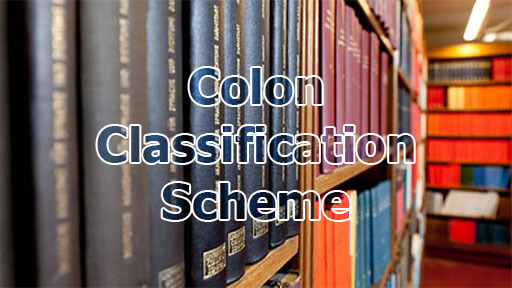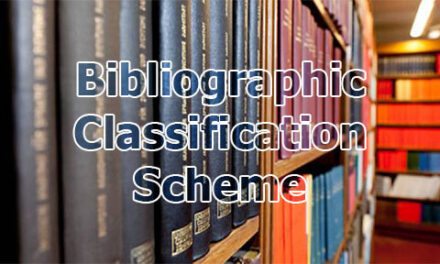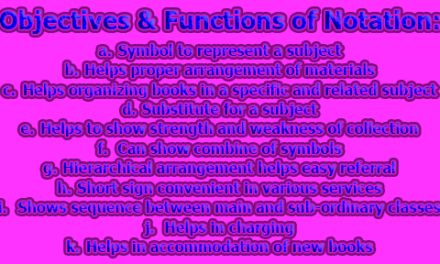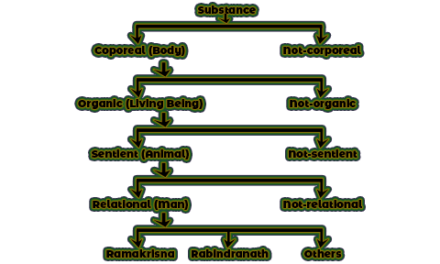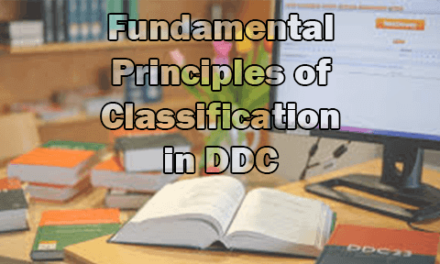Colon Classification Scheme:
Colon Classification is one of the most systematic schemes of library classification used in many libraries in India and a few libraries abroad as well. It was devised by Dr. S. R. Ranganathan who found the existing scheme of library classification unable to cope with the multi-dimensional dynamic growth of subjects. Colon Classification Scheme involves analysis and synthesis that is why it is known as “Analytico-synthetic” scheme of classification.
Basic Structure or Principles of CC Scheme:
CC proceeds in different manner in spite of enumerating all possible subjects and their sub-divisions, it analysis the subject in its various components and places them under five fundamental categories known as “Personality, Matter, Energy, Space, and Time (PMEST)”.
To connect or to synthesis the various components of a subject, different connection symbols have been provided. Readymade class numbers are also available, but to build a number, one has to analyze and pick up the possible isolates belonging to different fundamental categories which are then put together with the help of appropriate connecting symbols.
The PMEST formula indicates the sequence in which the foci from the several facets should be combined. The five fundamental categories may be shown in the form of a table with their respective connecting symbols:
| FC | Connecting Symbol | Symbol for the Facet |
| Personality | , (Comma) | P |
| Matter | ; (Semi-colon) | M |
| Energy | : (Colon) | E |
| Space | . (Dot) | S |
| Time | ’ (Inverted single comma) | T |
1. Personality: of all the fundamental categories ‘Personality’ is most concentrate but relatively most difficult to be recognized. It is the essence of the subject and without this a subject is somewhat formless.
Personality covers manifestation of wholeness, for example; Chemical Compounds, Plants and Animals, and Parts of them, Languages, Religions, etc.
In the main class Library and Information Science (LIS) concepts like; Library, Information Sources, Library Personnel, and users form the locus to the other fundamental categories. That is the reason these isolates belong to the fundamental category, Personality.
2. Matter: Any substance such as wood, paper, iron, silver, gold, chemical, etc. is the manifestation of ‘Matter’.
In the previous editions the category matter has been a somewhat obscure entity. In view of its expanded dimensions, it has acquired vast significance and occurs very frequently in the schedules wonder, the CC-7 may be called a ‘Semi-colon’ classification now. In the view of its vast and varied contents, it is not possible to have an encompassing definition. In short, it signifies either method or properly or material. Accordingly there are three variants of category [M].
(i) Matter – Property [MP]
(ii) Matter – Method [MM]
(iii) Matter – Material [MMt]
Amongst them, Fundamental or inherent properties of entities are designed as Matter Property [MP] e.g., Codes of Ethics.
Matter-Method implies various methods of some actions, e.g., Mechanical Method.
Material or Medium is Matter Material [MMt] e.g., Nitrogen Air, Matter-Material for curing diseases in [Botany,] Agriculture, K Zoology, and L Medicine.
For all three of them, the indicator is semi-colon “ ; ”
3. Energy: Energy is manifestation of action activities of all kinds. The activity could be mental or physical. In the 7th edition, the energy isolates in different main classes have been considerable reduced. However, a new feature is the addition of a long schedule of common energy isolates. Some of the examples of the category energy are; editing, dissemination, prevention, treatment, storing, cleaning, sorting, conservation, nursing, diagnosis, enrolment, teaching, admission, etc.
These examples provided an idea of the nature of the energy category. It is still an important category. In the Skelton facet formula. It is denoted as [E], in the class number it is preceded by colon “ : ” e.g.,
Gas Welding
FX : 8
4. Space: It is manifestation of geographical areas or population clusters. Any division of Earth such as; Oil Exporting Countries, English Speaking World, NATO, SAARC, are some examples, World-Asia, South-Asia, Bangladesh, North-West Bangladesh, Central Europe, London, Hilly Areas Valley, Disserts, Coastal Areas, are some of the examples of the space category in CC. Space is denoted by [S] in the Skelton facet formula; and in any class number [S] is preceded/indicated by dot, “ . ” e.g.,
Physical Geography of Germany
U2.55
5. Time: Out of the five fundamental categories, the ‘Time’ facet gives the latest difficulty in its identification. Obviously it is the Chronological factor in a subject. 20th century poetry, medieval science, contemporary culture, all these subjects have time as a component. In the CC-7, there is a provision to denote time more precisely and denote various kinds of time.
Chronological Solar, Lunar, Geological, Seasonal, Social, Meteorological, and so on. In the facet formula the time isolate is represented as [T] and in the class number the time isolate number is preceded by an apostrophe “ ’ ”. e,g.,
Libraries in 20th Century
2’N
Sometimes ‘Time’ is implicit in the subject:
- Reign of Asoka
- The Great European Renaissance
- Stone Age
- Second World War
- Industrial Revolution
- Space Age
In such a case, time facet will have to be made explicit.
Special Features of Notation of CC Scheme:
Some of the special features of notation of CC scheme are as follow with a brief description:
In brief:
- Its symbol are synthetic and analytic. Every facet has its individual symbol.
- This Scheme used the decimal method for numbers and letters.
- Mixed notation used here, the class number isn’t long here.
- This notation shows the relation amongst relative terms.
In detail:
(i) Sub-ordering: The first and foremost feature of the notation of this scheme is sub-ordering shows the order but doesn’t determine the order.
(ii) Mixed Notation: The notation of this scheme is mixed in nature; Arabic Numerals, Roman Capitals, Roman small, Greek Symbols and punctuations are used.
(iii) Simple: Because of its simplicity, notation in this scheme is comparatively easy to understand and comprehend.
(iv) Brevity: The reasons behind the brevity of the notation of this scheme is that equally is maintained in allocating the symbols.
(v) Hospitality: The specialty of the notation in this scheme is that its symbols are expansible than other schemes because both decimals and analytico-synthetic method applied here. Here notations are expanded in two level:
(A) Hospitality in Array: Here the notation of related subjects are expanded like;
a) Sector Device: In this process the last digit of Arabic numeral i.e., ‘9’ and the last letter of Roman capital i.e., ‘Z’ is used as a repeater. For examples;
I – 8
9I – 98
99I – 998
b) Group Notation: Sometimes two or more digit or letters are used in expansion process. e.g.,
11, 12, 13, ……… 18
81, 82, 83, ……… 88
c) Chronological Device: This scheme has a special provision for the inclusion of time. For example;
0 – Literature
0111 – English Literature
0111,2 – English Drama
0111,2J – Write of English Drama in 16th century
0111,2J64 – Shakespeare, who was born in 1564
d) Subject Device: By combination of two similar subjects, hospitality brings with in the notation. e.g.,
Z – Law, QZ – Hindu Religion
e) Alphabetical Device: Sometimes, part of the subject name used as symbol. e.g.,
J – Agriculture
J37 – Fruit
J37Ru –Rubas Nigna
f) Emptying Digit: In this scheme expansion brings by using the emptying digits (TUVWXYZ) within two similar subjects. e.g.,
B – Mathematics
BZ – Physical Sciences
C – Physics
g) Common Isolates: Alike the 7 tables in DDC scheme and common and special auxiliaries in UDC, common isolates are used in this scheme. Common isolates divided into two;
Asteriorizing Common Isolate (ACI)
Posteriorizing Common Isolate (PCI)
(B) Hospitality in Chain: Following process are followed in CC;
a) Chronological Isolates: Here Roman capital letter and Arabic Numerals are used as symbol, for examples;
A before 9999 BC
B 9999 – 1000 BC
C 99 – 1 BC
D AD1 – 999 AD
b) Geographical Isolates: Only Arabic Numerals are used here;
1 – Earth
4 – Asia
41 – China
42 – Japan
e.g., History of Japan – ‘V42’
c) Language Isolates: Arabic numerals also used in here. e.g.,
1 – Indo-European
11 – Teutonic
111 – English
113 – German
German language – 0113
d) Form Isolates: Roman small letter used here; e.g.,
a.– Bibliography
b. – Concordance
d. – History
In terms of literature, different literary forms are expressed in Arabic numerals and comma (,) used before that;
,1 – Poetry
,2 – Drama
,3 – Fiction
(vi) Synthesis: The synthesis is continued in every spare of this scheme. In this process, at first any class is divided into its constituent elements and then allocate under Facet. Later class number is determined by synthesizing these facets. Thus, it may be said that notation of CC is synthesizable.
At last we can say that Colon Classification is a general scheme which aims to classify by subject all kinds of documents books, periodicals, reports, pamphlets, microforms, and electronic media in all kinds of libraries. CC is the modern classification research and developments.

Library Lecturer at Nurul Amin Degree College

